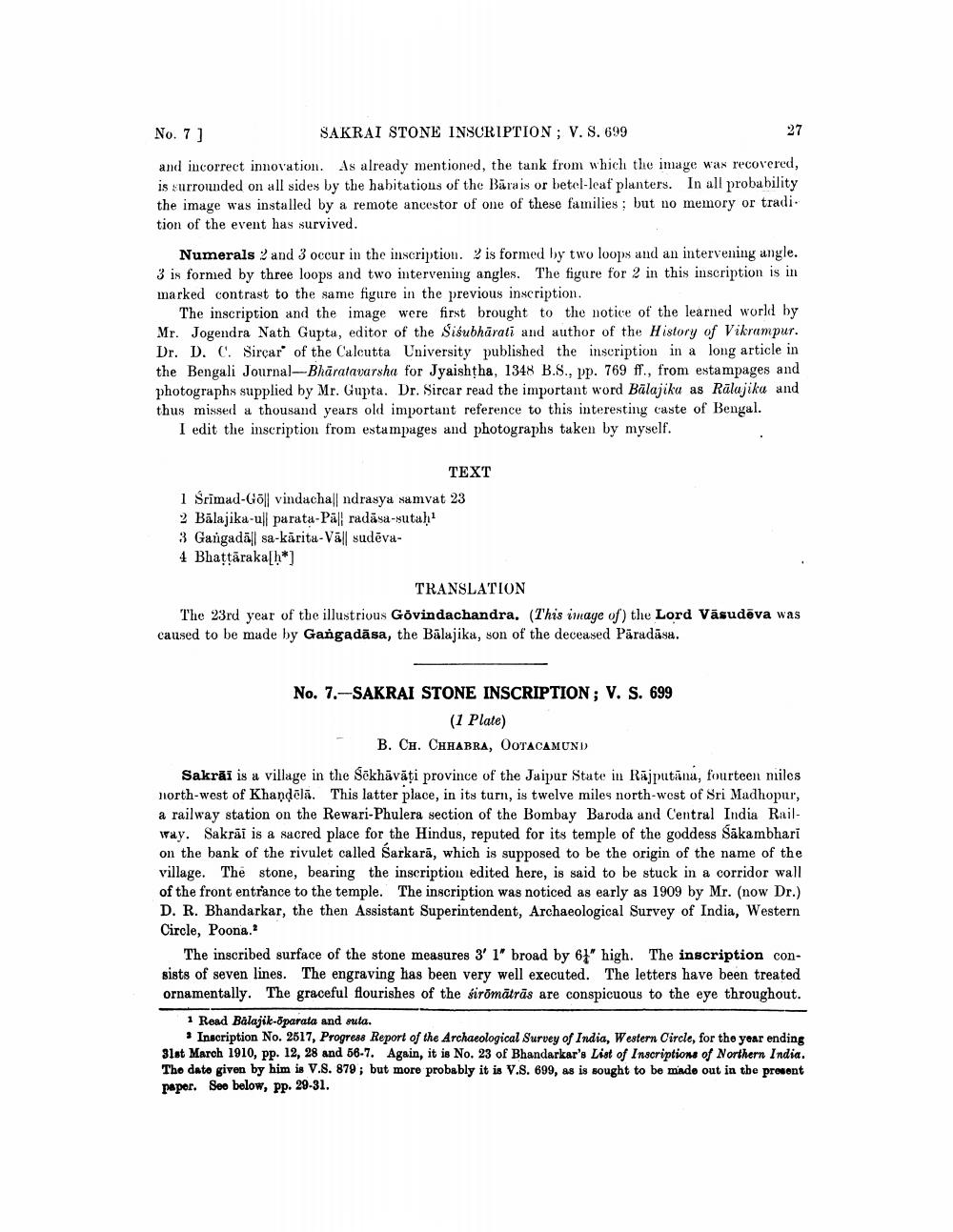________________
No. 7]
SAKRAI STONE INSCRIPTION; V. S. 699
and incorrect innovation. As already mentioned, the tank from which the image was recovered, is surrounded on all sides by the habitations of the Bära is or betel-leaf planters. In all probability the image was installed by a remote ancestor of one of these families, but no memory or tradi. tion of the event has survived.
Numerals 2 and 3 occur in the inscription. % is formed by two loops and an intervening angle. 3 is formed by three loops and two intervening angles. The figure for 2 in this inscription is in marked contrast to the same figure in the previous inscription.
The inscription and the image were first brought to the notice of the learned world by Mr. Jogendra Nath Gupta, editor of the Siśubhārati and author of the History of Vikrampur. Dr. D. (. Sircar of the Calcutta University published the inscription in a long article in the Bengali Journal-Bhäratavarsha for Jyaishtha, 1348 B.S., pp. 769 ff., from estampages and photographs supplied by Mr. Gupta. Dr. Sircar read the important word Balajika as Rālajika and thus missed a thousand years old important reference to this interesting caste of Bengal.
I edit the inscription from estampages and photographs taken by myself.
TEXT 1 Srimad-Göl vindachandrasya samvat 23 2 Bālajika-ull parata-Paradāsa-sutah 3 Gangadā|l sa-kārita-Vá|| sudēva4 Bhattāraka[h*)
TRANSLATION The 23rd year of the illustrious Govindachandra, (This image of) the Lord Väsudēva was caused to be made by Gangadāsa, the Bālajika, son of the deceased Päradāsa.
No. 7.-SAKRAI STONE INSCRIPTION; V. S. 699
(1 Plate)
B. CH. CHHABRA, OOTACAMUND Sakrāi is a village in the Sēkhāvāti province of the Jaipur State in Rājputāna, fourteen miles north-west of Khandēlā. This latter place, in its turn, is twelve miles north-west of Sri Madhopur, a railway station on the Rewari-Phulera section of the Bombay Baroda and Central India Railway. Sakrāi is a sacred place for the Hindus, reputed for its temple of the goddess Sākambhari on the bank of the rivulet called Sarkarā, which is supposed to be the origin of the name of the village. The stone, bearing the inscription edited here, is said to be stuck in a corridor wall of the front entrance to the temple. The inscription was noticed as early as 1909 by Mr. (now Dr.) D. R. Bhandarkar, the then Assistant Superintendent, Archaeological Survey of India, Western Circle, Poona.?
The inscribed surface of the stone measures 3' 1" broad by 6%" high. The inscription consists of seven lines. The engraving has been very well executed. The letters have been treated ornamentally. The graceful flourishes of the siromātrās are conspicuous to the eye throughout.
1 Read Balajik-õparata and outa.
* Inscription No. 2617, Progress Report of the Archaeological Survey of India, Western Circle, for the year ending 31st March 1910, pp. 12, 28 and 56-7. Again, it is No. 23 of Bhandarkar's List of Inscriptions of Northern India. Tho dato given by him is V.8. 879; but more probably it is V.S. 699, as is sought to be made out in the present paper. Seo below, pp. 29-31.




